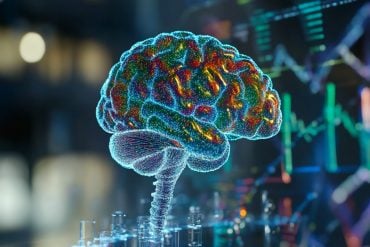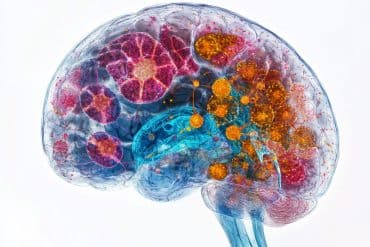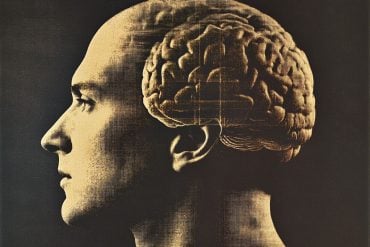Summary: Study reveals how gene control mechanisms determine the identity of neurons in the embryonic brainstem. A failure in differentiation in developing brainstem neurons can lead to behavioral abnormalities, including ADHD.
Source: University of Helsinki
A recent study at the University of Helsinki reveals how gene control mechanisms define the identity of developing neurons in the brainstem. The researchers also showed that a failure in differentiation of the brainstem neurons leads to behavioural abnormalities, including hyperactivity and attention deficit.
The mammalian brain is big, but the state of its activity is controlled by a much smaller number of neurons. Many of these are located in the brainstem, an evolutionarily conserved part of the brain, which controls mood, motivation and motor activity. What are the brainstem neurons like? How do they develop in the embryonic brain? How are defects in their development reflected in brain activity and behaviour?
The research group, led by Professor Juha Partanen at the Faculty of Biological and Environmental Sciences, University of Helsinki, has addressed these questions by studying gene regulation in the embryonic brainstem.
The phenotype of a neuron, to a large extent, is determined already early in an embryo. We have shown how certain selector genes, which are expressed soon after the onset of neuronal differentiation, and control the activity of other neuron specific genes, determine the identity of the developing neuron.
The past few years have provided us with very powerful tools to study gene expression in individual cells. By analysing gene products in embryonic brain cells, we can now follow the differentiation paths of neurons and examine what exactly happens when the developing cells take different paths – for example in becoming a neuron either inhibiting or activating its target.
Differentiation paths branch to produce the remarkable neuronal diversity that brain function is based on. According to the gene-expression-based identities, the immature neurons find their location in the brain and make contacts with other components of the neural circuitry.
What if the gene expression signposts point in wrong directions and the developing neurons are misrouted? In the brainstem, this has grave consequences on both brain function and behaviour.
In such a situation, “We have studied mice with an imbalance in differentiation of neurons either activating or inhibiting the dopaminergic and serotonergic neurotransmitter systems. These mice are hyperactive and impulsive, they have changes in their reward sensing and learning. Their hyperactivity can be alleviated with drugs used to treat human attention and hyperactivity deficits,” as Partanen clarifies.

In sum, Partanen indicates that, “Despite active research, the developmental basis of many human behavioural disorders are still poorly understood. We do not know yet if the human counterparts of the neurons we studied are involved in these deficits. Nevertheless, from the perspective of behavioural regulation, this specific group of neurons is highly important and there is still lot to learn about them.”
About this neurodevelopment research news
Source: University of Helsinki
Contact: Juha Partanen – University of Helsinki
Image: The image is credited to Samir Sadik-Ogli
Original Research: Open access.
“Molecular Fingerprint and Developmental Regulation of the Tegmental GABAergic and Glutamatergic Neurons Derived from the Anterior Hindbrain” by Samir Sadik-Ogli et al. Cell Reports
Abstract
Molecular Fingerprint and Developmental Regulation of the Tegmental GABAergic and Glutamatergic Neurons Derived from the Anterior Hindbrain
Highlights
- •GABAergic and glutamatergic precursors contribute to tegmental nuclei
- •The TF Tal1 and Notch signaling control neuron differentiation in the embryonic brainstem
- •TFs downstream of Tal1 mark and regulate development of specific tegmental nuclei
Summary
Tegmental nuclei in the ventral midbrain and anterior hindbrain control motivated behavior, mood, memory, and movement. These nuclei contain inhibitory GABAergic and excitatory glutamatergic neurons, whose molecular diversity and development remain largely unraveled. Many tegmental neurons originate in the embryonic ventral rhombomere 1 (r1), where GABAergic fate is regulated by the transcription factor (TF) Tal1. We used single-cell mRNA sequencing of the mouse ventral r1 to characterize the Tal1-dependent and independent neuronal precursors. We describe gene expression dynamics during bifurcation of the GABAergic and glutamatergic lineages and show how active Notch signaling promotes GABAergic fate selection in post-mitotic precursors. We identify GABAergic precursor subtypes that give rise to distinct tegmental nuclei and demonstrate that Sox14 and Zfpm2, two TFs downstream of Tal1, are necessary for the differentiation of specific tegmental GABAergic neurons. Our results provide a framework for understanding the development of cellular diversity in the tegmental nuclei.






